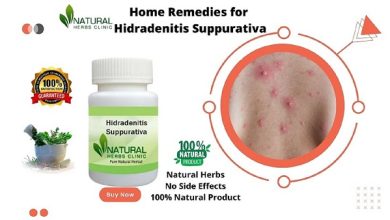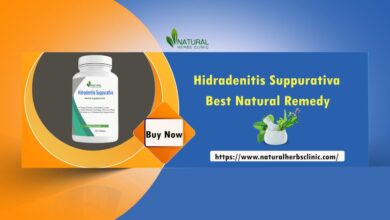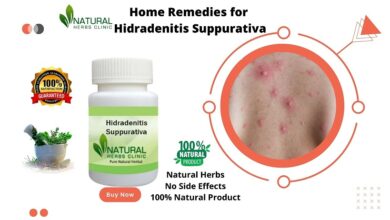The Science Behind Essential Oils for Hidradenitis Suppurativa Relief

Hidradenitis Suppurativa (HS) is a chronic, often painful inflammatory skin condition that affects millions worldwide. Characterized by recurrent boil-like lumps, abscesses, and sinus tracts (tunnels under the skin), HS most commonly affects areas where skin rubs together, such as the armpits, groin, buttocks, and under the breasts. The exact cause of HS is not fully understood, but it is believed to involve hair follicle blockage, immune system dysregulation, hormonal influences, and bacterial overgrowth. Treatment is often challenging and typically involves a combination of antibiotics, anti-inflammatory medications, surgical interventions, and lifestyle changes.
In recent years, many people with HS have explored natural approaches to complement conventional care, one of which is essential oils. Proponents claim that essential oils can help reduce inflammation, fight bacteria, relieve pain, and promote skin healing. But how much of this is supported by science? We will dive deep into the science behind essential oils for Hidradenitis Suppurativa, their potential mechanisms, safety considerations, and evidence-based usage strategies.
Related Article: How to Cure Hidradenitis Suppurativa Naturally: Proven Methods for Clear Skin
Understanding Hidradenitis Suppurativa
1. What is Hidradenitis Suppurativa?
Hidradenitis Suppurativa (HS) is a chronic, inflammatory skin condition that causes painful lumps (also called nodules or abscesses) to form deep under the skin.
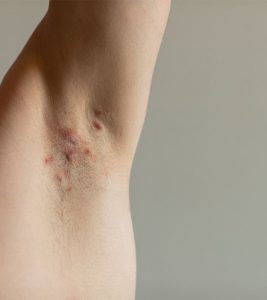
It is not contagious and not caused by poor hygiene.
The condition tends to affect areas where skin rubs together and where there are many sweat glands, such as:
- Armpits
- Groin
- Buttocks
- Under the breasts
Over time, HS can lead to tunnels under the skin (called sinus tracts) and scarring.
2. Why Does It Happen?
The exact cause isn’t fully understood, but it involves hair follicles and inflammation.
Here’s the basic process:
- Hair follicle blockage → caused by abnormal keratin build-up or inflammation.
- Follicle rupture → triggers immune system reaction.
- Inflammatory response → leads to swelling, pain, pus, and chronic lesions.
Factors that may contribute:
- Immune system dysregulation – similar to other inflammatory diseases.
- Genetics – runs in families in about 30–40% of cases.
- Hormones – often starts after puberty, can flare with menstrual cycle changes.
- Lifestyle and environment – obesity, smoking, friction, and heat can worsen symptoms.
3. Symptoms
HS typically goes through cycles of flare-ups and remission. Common signs include:
- Painful red bumps under the skin
- Boil-like abscesses that may leak foul-smelling pus
- Blackheads in pairs (“double-headed comedones”)
- Skin tunnels that connect abscesses under the surface
- Thick, rope-like scarring in chronic stages
Severity is classified using the Hurley Staging System:
- Stage I – Single or multiple abscesses without sinus tracts or scarring.
- Stage II – Recurrent abscesses with sinus tracts and scarring, but lesions are widely spaced.
- Stage III – Multiple interconnected tracts and abscesses across an entire area.
What Are Essential Oils?
Essential oils are highly concentrated, aromatic extracts taken from plants. They are typically obtained through steam distillation (where steam is used to release and collect the plant’s volatile compounds) or cold pressing (most often used for citrus peels, where mechanical pressure extracts the oil). These methods preserve the plant’s natural fragrance along with its chemical compounds many of which can have biological effects on the body.
Because essential oils contain a high concentration of active plant molecules, they can influence the skin, immune system, and even mood. The exact effects depend on the plant source and the chemical makeup of the oil.
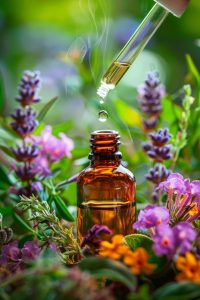
Why They’re of Interest for Hidradenitis Suppurativa (HS) Management
Some essential oils contain properties that may help with the symptoms of HS:
- Antimicrobial effects – Certain oils can prevent or slow the growth of bacteria, fungi, and in some cases viruses. For HS, this may help reduce skin infections or flare-related bacterial activity.
- Anti-inflammatory action – Many oils can lower the production of pro-inflammatory cytokines (chemical messengers that trigger swelling and irritation), which may help calm inflamed HS lesions.
- Analgesic properties – Some oils contain compounds that dull nerve signals, providing localized pain relief for tender HS areas.
- Wound-healing potential – Specific oils can stimulate cell regeneration and improve tissue repair, potentially supporting faster healing of HS-related wounds.
These effects are mainly due to bioactive compounds in the oils, such as:
- Terpenes – Known for anti-inflammatory, antiseptic, and soothing properties.
- Phenols – Potent antimicrobial agents.
- Aldehydes – Often calming to the skin and anti-inflammatory.
- Esters – Can help with pain relief and skin soothing.
Related Article: 3 Effective Hidradenitis Suppurativa Treatment Home Remedies
The Link Between Essential Oils and HS Symptoms
To see where essential oils may help, we need to map HS symptoms to potential essential oil properties:
| HS Symptom | Possible Essential Oil Benefit | Example Oils |
| Pain & tenderness | Analgesic, anti-inflammatory | Lavender, Helichrysum |
| Redness & swelling | Anti-inflammatory | Tea Tree, Chamomile |
| Drainage with odor | Antimicrobial, deodorizing | Tea Tree, Lemongrass |
| Slow healing | Skin-regenerative | Frankincense, Rosehip |
| Bacterial overgrowth | Antibacterial | Oregano, Thyme |
While essential oils are not a cure for HS, they may provide symptom relief and support skin health when used safely alongside medical treatments.
Related Article: Hidradenitis Suppurativa and Diabetes: How to Reduce Inflammation and Heal Faster
Scientific Evidence on Essential Oils for Hidradenitis Suppurativa
Although there are no large-scale clinical trials specifically on essential oils for Hidradenitis Suppurativa, there is robust research on the antimicrobial and anti-inflammatory properties of individual oils in other skin conditions. Let’s examine the most relevant ones.
1. Tea Tree Oil (Melaleuca alternifolia)
Why it’s relevant for HS:
Tea tree oil is one of the most researched essential oils for skin health. Its main active compound, terpinen-4-ol, has strong antibacterial and anti-inflammatory activity.
Scientific evidence:
- A 2006 study in Clinical Microbiology Reviews found tea tree oil effective against Staphylococcus aureus, a bacterium often found in HS lesions.
- Research in Skin Pharmacology and Physiology (2013) confirmed its ability to reduce skin inflammation and promote healing.
Potential benefits for HS:
- Reduces bacterial load on the skin.
- May decrease odor from draining lesions.
- Calms localized inflammation.
Caution:
Tea tree oil can be irritating if applied undiluted. Always dilute in a carrier oil.
2. Lavender Oil (Lavandula angustifolia)
Why it’s relevant for HS:
Lavender oil is known for its calming scent, but it also has notable anti-inflammatory and analgesic effects.
Scientific evidence:
- A 2015 review in Evidence-Based Complementary and Alternative Medicine reported lavender oil’s ability to reduce pain perception and support wound healing.
- It has mild antibacterial activity, which can help reduce the risk of secondary infection.
Potential benefits for HS:
- Soothes irritated skin.
- Helps manage pain and tenderness.
- Reduces stress, which may indirectly minimize flare-ups.
3. Frankincense Oil (Boswellia species)
Why it’s relevant for HS:
Frankincense contains boswellic acids, known for their strong anti-inflammatory action.
Scientific evidence:
- Studies in Planta Medica have shown boswellic acids can inhibit pro-inflammatory enzymes, similar to some NSAIDs.
- Traditionally used for wound healing and scar reduction.
Potential benefits for HS:
- Reduces swelling and inflammation.
- May help with scar healing after HS lesions resolve.
4. Chamomile Oil (Matricaria recutita or Chamaemelum nobile)
Why it’s relevant for HS:
Chamomile oil contains bisabolol and chamazulene, compounds with skin-soothing effects.
Scientific evidence:
- A study in Journal of Drugs in Dermatology (2010) found chamomile extracts effective in reducing dermatitis symptoms.
- Known for reducing redness, irritation, and swelling.
Potential benefits for HS:
- Gentle anti-inflammatory support.
- Suitable for sensitive skin prone to irritation.
5. Oregano Oil (Origanum vulgare)
Why it’s relevant for HS:
Oregano oil is rich in carvacrol and thymol, potent natural antimicrobials.
Scientific evidence:
- Research in Frontiers in Microbiology has shown oregano oil effective against antibiotic-resistant bacteria.
- Particularly useful for skin infections where bacteria exacerbate inflammation.
Potential benefits for HS:
- Strong antibacterial activity for infected lesions.
- Should be used cautiously due to high potency.
Related Article: Get Hidradenitis Suppurativa Home Remedies to Relieve the Symptoms
Mechanisms: How Essential Oils May Work in HS
Essential oils may influence HS symptoms through multiple pathways:
- Antimicrobial action:
HS lesions often harbor bacteria like Staphylococcus aureus or Streptococcus pyogenes. Essential oils can penetrate biofilms and reduce bacterial colonization. - Anti-inflammatory modulation:
Oils like frankincense and chamomile reduce cytokine release (e.g., TNF-α, IL-1β), calming immune overreaction. - Pain relief:
Compounds such as linalool (in lavender) can modulate pain signals and reduce nerve sensitivity. - Skin regeneration:
Certain oils stimulate fibroblast activity and collagen production, aiding wound closure.
Safe Usage of Essential Oils for Hidradenitis Suppurativa
Important: Essential oils are potent and must be handled with care, especially on broken or sensitive skin.
1. Dilution Guidelines
Always dilute essential oils in a carrier oil before applying to skin:
- Standard dilution: 1–2% (about 6–12 drops per ounce of carrier oil).
- Carrier oils for HS-prone skin: jojoba oil, coconut oil (antimicrobial), or grapeseed oil.
2. Patch Testing
Before regular use, apply the diluted oil to a small skin area and wait 24 hours to check for irritation.
3. Avoiding Broken Skin
Do not apply essential oils directly to open or draining lesions. Instead, apply around the area or use gentle compresses.
4. Medical Interactions
Some oils can interfere with medications or cause allergic reactions. Consult your dermatologist before adding essential oils to your HS care plan.
Related Article: Make Use of Given 10 Natural Remedies for Hidradenitis Suppurativa
Lifestyle Strategies to Complement Essential Oil Use
To maximize the potential benefits of essential oils Treatment for Hidradenitis Suppurativa, integrate them into a broader wellness plan:
- Maintain good hygiene without harsh soaps.
- Wear loose, breathable clothing to reduce friction.
- Follow an anti-inflammatory diet rich in vegetables, omega-3s, and low in processed foods.
- Quit smoking, as it significantly worsens HS.
- Manage stress with meditation, yoga, or deep breathing stress can trigger flare-ups.
Final Thoughts
Essential oils for Hidradenitis Suppurativa are an intriguing complementary option that may help reduce inflammation, soothe pain, and control bacterial overgrowth. Oils such as tea tree, lavender, frankincense, chamomile, and oregano each bring unique properties that could support symptom management.
However, essential oils should never replace prescribed treatments. They work best as part of a holistic, dermatologist-guided care plan, where safety, proper dilution, and skin sensitivity are prioritized.
Related Article: Natural Remedies for Hidradenitis Suppurativa Reduce Growth of More Lumps


